Menus
- Mechanical gearbox, DCT, standard or bagger version ?
- Discovery
- In the saddle
- In the city
- On the highway
- Departmental
- Braking
- Comfort / Duo
- Convenient
- Consumption
- Revisions
- Conclusion
Mechanical gearbox, DCT, standard or bagger version ?
The Gold! Almost 45 years of history observe you from this saddle … Because if the Honda Goldwing has changed profoundly since its launch in 1974, it had hardly changed since its last big evolution in 2001, apart from its improvements in 2012. So it had been almost 20 years since she had moved. We knew that Honda had been working on it for a long time and the presentation at Eicma in 2017 therefore literally shook the foundations of this model which, more than a model, has always been the benchmark of luxury on motorcycles. And as much as the Goldwing has grown and overweight over time, with the 2018 vintage, it is a question of weight loss while being at the forefront of technology in terms of on-board techno and entertainment. So, the Goldwing is it always a Gold or almost a Pan and which model to choose between old model, new model with or without DCT box, bagger or not. Comparative test
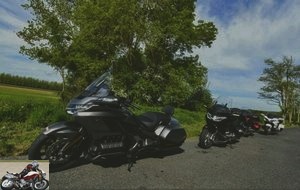
Discovery
There was a Goldwing. There are now three! In fact, Honda now offers the Goldwing in a standard version, the bagger (farewell to the F6B at the denomination level) and a Tour version (with the topcase) in a manual gearbox version and in a DCT version, with or without an airbag with prices that make it big. difference of 26 to 36,000 euros.
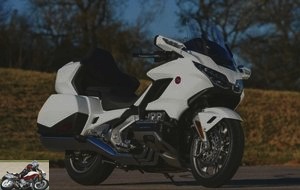
And this new Gold is an entirely new model that breaks aesthetically with the old, more refined and modern. The LEDs take over the model, the start is done without a key (Smartkey), the screen becomes TFT in maxi-size (7 "), start & stop makes its entry as well as several modes with Touring, Sport, Eco mode and Rain and the DCT version is gaining speed, with 7 gears! Underneath, the frame is completely new, not to mention an entirely new fork with a double wishbone suspension, contributing to the 50 kilos less of the model.
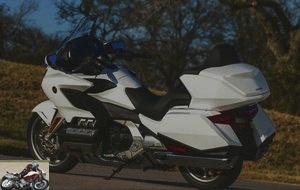 *
*
There is hardly that the 6 cylinders which is preserved even if the engine has in reality been largely revised and not only because of the DCT box..

In the saddle
The saddle height is almost the same as the old model (745mm against 740mm) and is barely higher than some customs suggesting that a small size will put both feet on the ground. But the saddle is very wide, suddenly, a driver of 1.70m will put just the tip of the feet on the ground. We are seated, very well seated even and the handlebars fall naturally under the hands but you have to make a little effort to enclose the tank. In fact, we tend to have the thighs a little apart naturally suddenly. The slightly better shaped saddle makes it easier to move on it. The eyes are in front of an airplane cockpit with all the instrumentation, the various and varied buttons everywhere on the left and right commodos, completed by a screen that can alternate the displays. It could not be more complete and it takes a little time to assimilate everything. For once, it may be useful to read the notebook.
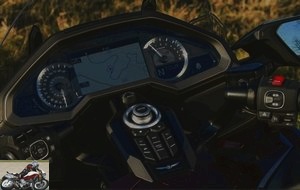
But hey, to drive, it remains – almost – identical. With the smartkey in your pocket, you start by turning the large central button. First at the bottom, straight handle, the position is almost identical to the previous version and a former Gold driver will not be disoriented. A little boost and the Gold takes off slowly, finding what was already a characteristic of the old model: ease of driving from 5 km / h with an impressive overall balance. This may be the reason why the Gold recruits from 25 years old (the youngest of the Goldwing Club) and that we still lead it at 84 years (the oldest of the Goldwing Club).
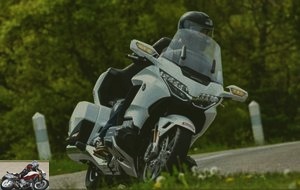
In the city
There is hardly any play of the clutch at the start and on the first reports so the six cylinders is easy and smooth. We can then drive on the last report at 500 rpm and it resumes. We almost think that the first and the last report would be enough. To this game, in town, I prefer the manual gearbox, especially because a finger on the clutch allows you to play smoothly when starting. And that even in first, you can ride smoothly in the city. This is when you really appreciate the new saddle shape which allows you to always have the same position. On the old one, we had to get back noticeably forward when we were wedged to the bottom of the saddle in order to be able to dismount. Here, whatever the position, you don’t need to play to be able to put your foot on the ground. Low-speed maneuvers are relatively easy, especially since there is a reverse gear with even two speeds, connected to the mechanical gearbox or to an electric motor depending on the gearbox, mechanical or DCT. And it’s just magic to get out of a parking space between two cars. Because the Gold is wide and long and will not fit naturally into motorcycle parking spaces. Its width is not negligible in inter-row even if this new vintage is less wide, in particular at the level of the suitcases and therefore makes it possible to squeeze a little more easily. It is possible, but it is still not the level of ease of a roadster, even big. In town, Rain or Eco modes will be ideal.
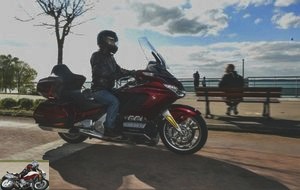
On the highway
We enter the motorway dynamically while the engine purrs at 140 km / h at only 3,000 rpm, halfway through the red zone at 6,000 rpm … which means that a slight rotation of the handle leads you to shameful speeds … but not too much, because the Gold is restricted … at 180 km / h. This will only bother our German friends since anyway, in France, it is prohibited and at this speed, you lose your license. The old one was not restrained and could take 210 km / h. We will console ourselves by putting the cruise control and enjoying the protection. The slightly narrower bubble can generate some pressure on the arms, but for the driver of 1.70m, it is high enough to deflect the flow of the wind above the head and without any disturbance behind or particular infrasound. Suddenly, you can cruise quickly, being completely protected and especially in terms of noise. Because the sound level is particularly low once the electric bubble is deployed at its highest level. Frankly, we could cruise with 180 km / h in extreme comfort that has no equivalent, except maybe the K1600.
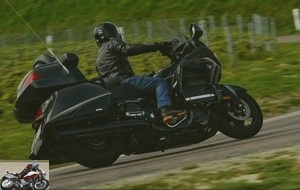
Departmental
As much as the K1600 is on a par with the Gold on the motorway, the advantage here goes to the Gold, so much its handling aided by a low center of gravity and a much lower weight facilitate the dynamics on small roads. And it is also on small roads that the DCT box takes all its interest, even if once again the box is so flexible, that we can stay on the last report all the time. Because the six-cylinder allows you to enter the villages on the last gear by rolling up without knocking and respecting the limits to resume dynamically at the exit.
Because if the DCT box has reached maturity with the base 750 including with the last X-ADV, it is even smoother with the six cylinders, without the klonks that we heard in its first version. Only the first gear is a little more brutal than the equivalent in the mechanical gearbox version when you can play with the clutch. But apart from this detail, the DCT version is a treat, to enjoy until the overdrive and its seventh report. Yes, the DCT box has a higher speed than the mechanical box.
In normal use, the Touring mode is really the choice to make offering the ideal mix between dynamics and flexibility, the eco and rain modes being soft on the go-around. As for the Sport mode, it offers a renewed recovery and power that we did not believe possible on a granny of 365 kilos (in running order). The pickups are really dynamic and are closer to a smaller displacement with a higher weight / power ratio. The turns then sometimes arrive too quickly and we will not forget that the overall weight requires a minimum of anticipation. Because as much, the big curves are taken very quickly on national and with precision, as much the virolos require a minimum of anticipation. There is no question of improvising here at the last moment as we do with certain roadsters or sports cars.
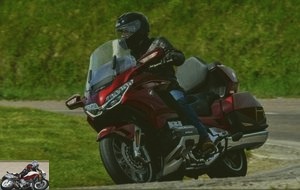
Braking
The rear brake is efficient and more than reassuring and homogeneous with a front brake offering an excellent feeling and all the necessary power..
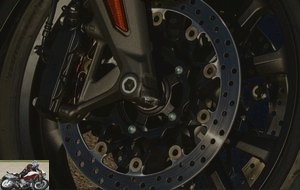
Comfort / Duo
For our one-day test, we made a loop of nearly 500 kilometers, only through small roads and the comfort was there even if the saddle gives the impression of not having as much softness as the ‘old model. This is just an impression. It especially offers easy accessibility for small riders and an overall position that I much prefer compared to the old model..
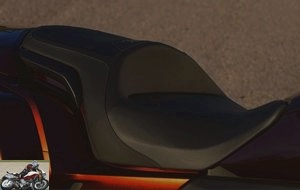
Convenient
The Goldwing lost in carrying capacity with now only 110 liters. But we still manage to put two integral in the top-case, with the reservation that it depends on the integral and that we will not put two modular as before..
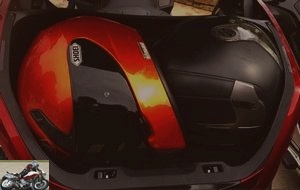
The Goldwing has a central stand in addition to the side and despite the weight of the machine, the stand is quite easy.
Consumption
If the tank has lost a few liters, from 25 to 21 liters, consumption has also been reduced, pointing to 5.7 l / 100 during our test, however well conducted and allowing to consider a range of 400 kilometers.
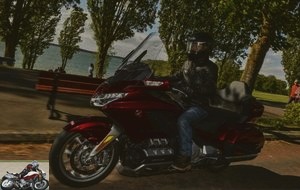
Revisions
The Gold goes for service only every 12,000 km and a set of tires is normally 30,000 km. Mechanical accessibility has been improved even if access to some parts requires a lot of disassembly and therefore hours (unless you do it yourself).

Conclusion
One would have thought that the Golwing could have lost its soul by reducing its carrying capacity and its weight by bringing it almost closer to a Pan European, but it is not. Comfort is still largely there while the driving modes and DCT bring a real plus, not to mention the TFT screen which now puts it at the level of the best and in particular the Roadmaster at Indian. It remains its price, more expensive than a BMW K1600, but affordable in the bagger version at 25,999 € but which begins to increase seriously in the Tour version at 32,999 € and especially in the DCT / Airbag version at 35,999 € which places it close to the Price of a Street Glide CVO but with a much greater ease of daily driving, especially for small jigs. For having made a great roadtrip in Norway with the bagger of the time of the F6B, including with a return of 1,700 km in one day, the bagger is already the solution to the trip to the duo then the Tour version … But the pleasant surprise of this comparison, it is really the DCT version which brings a real plus in daily driving comfort when handling a vessel of this type. There remains its price which will reserve it for the most fortunate. So, whatever the version in any case, this new generation Honda Goldwing makes you want to discover the roads of the whole world even more on board..
Strong points
- motor
- comfort
- techno: driving modes, TFT screen, DCT
Weak points
- reduced payload capacity
Honda Goldwing technical sheet
Test conditions
- Itinerary: small varied roads + interurban highways with a bit of town
- Motorcycle mileage: 500 km
Related articles
-
Testing of DCT and mechanical gearbox versions After five years of waiting, the Honda road flagship is completely reinventing itself. Aesthetics,…
-
Honda Honda Goldwing GL 1800 motorcycle test
Test over 3000 km of the GT par excellence The Honda Goldwing GL 1800 is undoubtedly the benchmark for Grand Touring motorcycles, the very symbol of the…
-
Comparative motorcycle test Kawasaki Ninja 650 A2 and full
Daily trial for 15 days of both versions 649 cc, 68 hp – 47.5 hp in A2 – for 193 kilos Who remembers the ER-6, the model unveiled in 2005 and since…
-
The roadster in its travel livery and double clutch Good at everything Honda brought to motorcycles the concept developed in the automobile in the 90s:…
-
Flatteries of flat Appeared forty years ago (already!), The Honda 1000 GoldWing was the first behemoth produced in large series. A limousine on two…
-
2012 Honda Goldwing GL 1800 motorcycle test
Majestic Asphalt Diva. Icon of road machines, imposing and luxurious, Honda carves out its generous muse with small touches. Thus, 2012 will certainly…
-
Honda GoldWing GL1800 DCT motorcycle test
An armchair for two, luxury cruise, Mobile lounge 6 cylinders flat, 1,833 cm3, 126 hp and 170 Nm, Tour and standard version (bagger), from € 27,899 to €…
-
Bagger: custom touring with integrated luggage 1,500 km test The custom is in vogue, especially in its bagger version, that is to say with on-board…
-
Honda CBR 600 RR motorcycle test
1700 km test The CBR 600 RR is the Honda hypersport, the ultimate weapon of the Hamamatsu firm, whose lineage with the RC211V is evident. The 2010…
-
Honda CBF 1000 ABS motorcycle test
The Honda CBF 1000 is the big sister of the CBF 600, which appeared in 2006. Apart from a slightly larger size, the two models are aesthetically very…